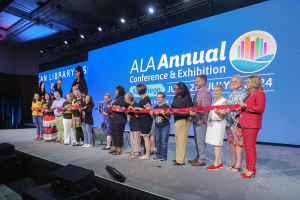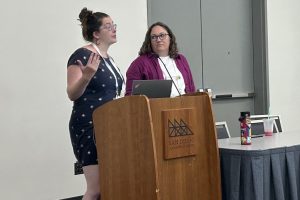
Leslie Flynn, library associate at Austin (Tex.) Public Library, remembers an instance during a manga-related program at her library where youth and adult patrons formed an unlikely connection.
“Adults actually started getting recommendations from the high schoolers because they’re new to the genre and don’t know what to read next,” she said. “[The two groups] come from different points initially, but I think they all end up being in the same type of stream.”
Flynn shared ways to curate a manga collection for older audiences at the library during “It’s Not Just for Teens! Building Great Manga Collections for Adults,” a June 29 session at the American Library Association’s 2024 Annual Conference and Exhibition in San Diego. She was joined by Deb Aoki, member of ALA’s Graphic Novels and Comics Round Table (GNCRT) and host of the Mangasplaining podcast; Ben Applegate, director of the Kodansha manga editorial team at Penguin Random House; and Joe Pascullo, young adult librarian at New York Public Library.
Manga’s popularity in America has seen a boom in recent years, Aoki said, and she can pinpoint two contributing factors.
“In 2020 and 2021, people were in lockdown seeking a community, and the manga community online was there to receive them and take them on a journey,” she said. “And part of the appeal of that journey is the fact that most manga are a trip into different cultural perspectives, and that’s a beautiful thing for someone who’s seeking something outside of the mainstream of pop culture.”
What makes manga unique is that it can span many different genres, provide numerous layers of representation, and cater to multiple audiences. This is why it can be tricky to organize manga collections in libraries, the panelists acknowledged. Each library forms its own method.
“It does take effort to figure out where things should go,” Applegate noted, adding that the rating system for manga is complex due to cultural differences between Japan and the US.
“Who’s reading our adult manga? The teens,” Pascullo said. “Some [manga] are in YA, some are in adult. They’re going to find it, whether you separate it or not.”
Each panelist shared recommendations of manga series to add to an adult collection, from slice-of-life romance title A Sign of Affection to giant monster-fighting action title Kaiju No. 8. Flynn and Pascullo noted different ways to stay in the know of up-and-coming manga.
Flynn noted: “If you join [GNCRT], you get access to our Discord, which has an entire manga channel where you can just go talk to other librarians.”
“I definitely think attending industry panels is so beneficial,” Pascullo added. “You get to meet the publishers themselves and ask questions and make contacts.”


